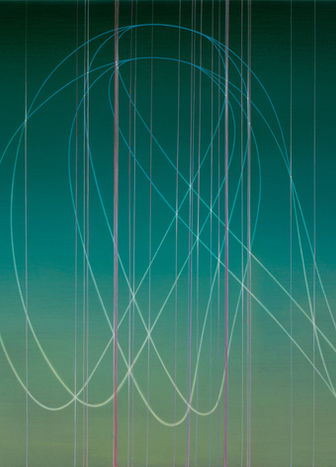interview
What inspired you to become an artist and when did you start taking art seriously?
I grew up in a family of artists and came into contact with artists who inspired me. I remember pondering the relationship between the line and the circle as a small child. This question has never left me since.
Which artists or art movements have most influenced your style and work?
Renaissance art has influenced me the most, but I also find contemporary Japanese art and the European art movement of the early 20th century very interesting.
Could you walk us through the creative process you go through when creating a new piece?
I begin the work after a long gestation process and make slight adjustments along the way.

Is there a particular theme or message you want to convey in your work?
I tend to look for visual representations of mathematical concepts that have universal/metaphorical meaning.
What has been the biggest challenge on your artistic journey so far and how did you deal with it?
In my experience, the last project seems to have been the most challenging.
Are there any techniques and materials that you prefer?
Since I like to build my paintings with many thin layers, I often use acrylic before applying the final layer of oil. I often use the two materials separately.
Is there a particular place where you prefer to work?
I just need silence and solitude.
Where do you see yourself and your art in the next five years?
I hope to have the opportunity to paint large pictures and work on installations that I have been thinking about.
Do you have a "philosophy" that guides your creative expression?
In my opinion, visual art is an aspect of our lives that cannot really be spoken about. At best, it can lead to pure sensation. This is what Malevich was talking about when he defined Suprematism.
What advice would you give to other young artists who are just starting out?
Never give up the belief that art is the only sensible thing you can do in life. If you lose that belief, give yourself a program to follow.
Katalin Haász was born in Budapest in 1971 and began her artistic training in her teens. From 1985 to 1989, she attended the Secondary School of Fine and Applied Arts in Budapest. She then studied at the Hungarian Academy of Fine Arts, where she graduated in 1997 with a degree in painting and intermedia. Her teachers included Dóra Maurer and Miklós Peternák, who had a significant influence on her. Her work is strongly influenced by concrete and constructivist art. In her paintings, she addresses issues of modernism as explored in the works of Wittgenstein and Malevich. She is also a member of the Open Structures Art Society (OSAS), which underscores her affinity for structural and geometric art. Haász explores themes such as infinity, structure, and transformation. She uses motifs such as the chessboard and the Möbius strip to visually represent closed systems and the concept of infinity. An example of her creative process is the "Sundial Projections" series. Here, she used a Möbius strip as a shadow caster to capture hourly shadow lines between 8 a.m. and 6 p.m. These lines served as the basis for her paintings, which depict complex geometric patterns. "I created the first Möbius painting in 1998, and it has remained my central theme ever since."
In 2008, I made a sundial in which the shadow cast by the hand was a Möbius strip. I traced the shadow cast every hour. Due to the constantly changing angle of the sun, the Möbius strip cast a variety of shadow shapes, forming a geometric structure. This system of lines served as the basis for the "Prelude" series.
In the "Moments at Works" series, in which I returned to the linear structure of the sundial, the lines became finer than in the "Prelude" series, creating the impression of a graphic work. In this series, the point represents a moment in time, the line a segment of space-time. The successive time projections intersect at specific points. Highlighting these points, depicting them simultaneously, and rhythmically arranging the corresponding lines pose an exciting artistic problem. The manual arrangement of the line system and their intersection points requires many repetitive interventions on the picture surface. Through these repetitions, mathematical and philosophical questions can be transformed into a personal experience.
For me, the Möbius strip represents the tangible form of spatial and temporal infinity, and the totality of its projections offers a unique space-time experience.
In different phases of life, time and space intersect in infinitely diverse ways. When we travel, for example, the passage of time synchronizes with the increasing spatial distance. The series "Moments at Works" is a visual representation of the synchronicity of time and space. The simultaneously imaginary and concrete space and time of the images invite free association.


















